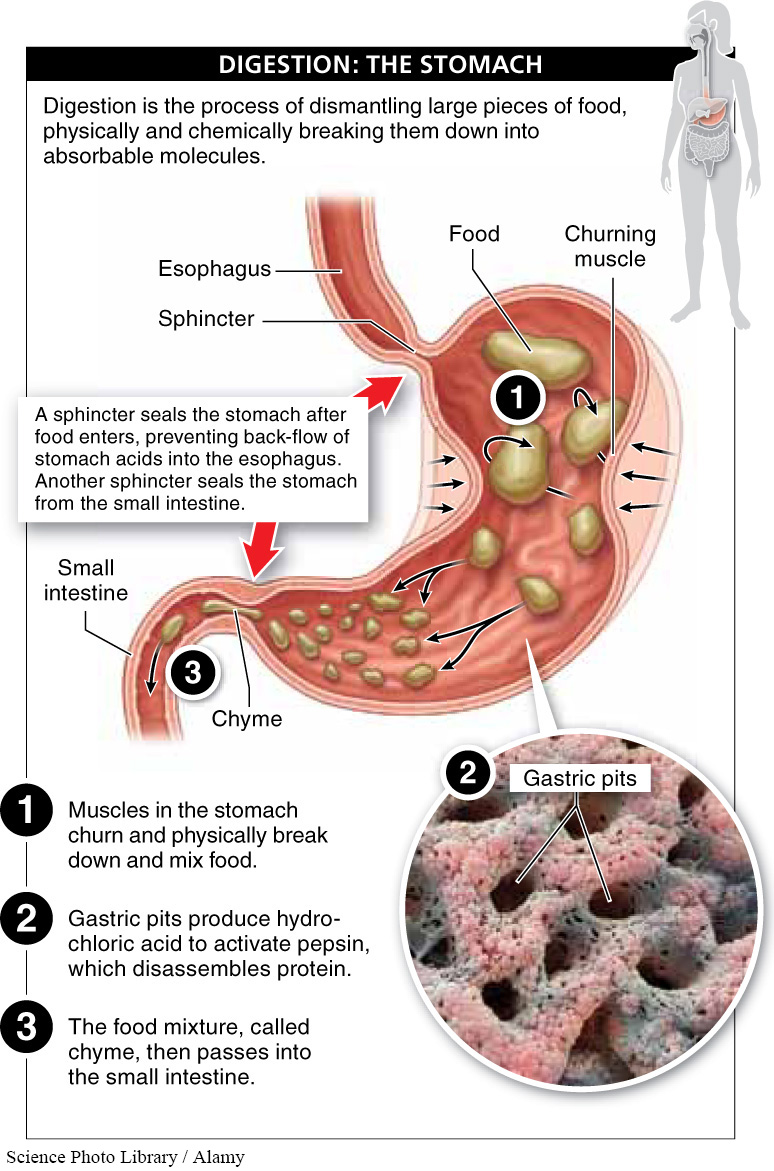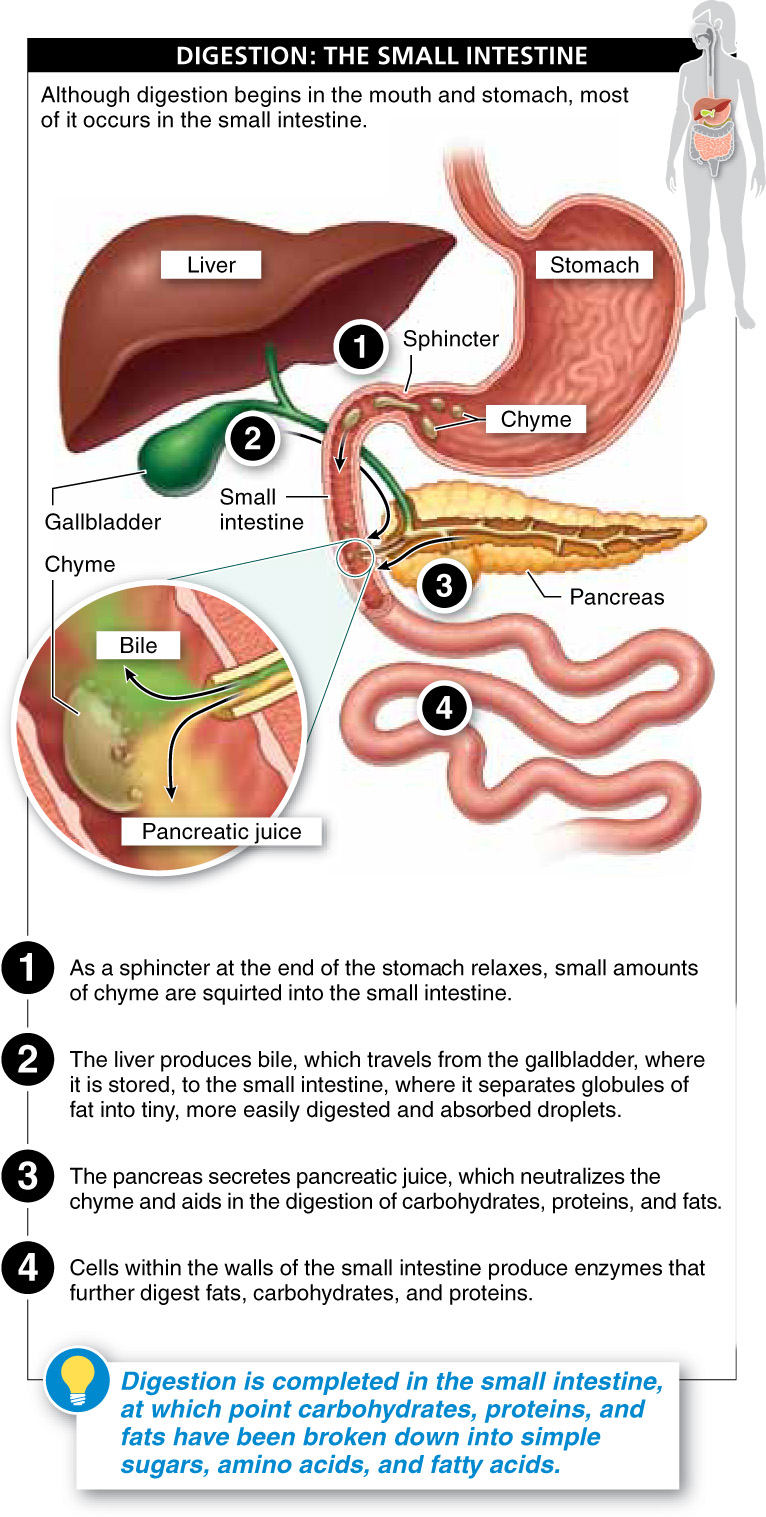
Food is fuel. But it is useless to an animal until it has been completely broken down into its fundamental chemical constituents. Only then can it be absorbed into the bloodstream and used constructively. The process of dismantling the large pieces of food, physically and chemically breaking them down into absorbable molecules, is digestion. It occurs primarily in the stomach and small intestine.
The Stomach The bite of hamburger moving through the digestive system empties from the esophagus directly into the stomach, a muscular J-
The stomach has three functions.
- 1. It physically breaks down and mixes food, through churning of the muscles surrounding the stomach.
- 2. It secretes acid to further break down food chemically and to kill bacteria.
- 3. It begins some chemical digestion of proteins.
891
The presence of food in the stomach causes cells in crevices within the stomach lining, called gastric pits, to rapidly produce hydrochloric acid and pepsinogen, a precursor molecule quickly converted to the protein-
What is indigestion? How do antacids cure it?
The burning sensation of indigestion occurs when the sphincter between the esophagus and the stomach doesn’t completely prevent the acidic contents of the stomach from moving back up the esophagus. It usually occurs when a person eats too much or too quickly. Antacids can neutralize acid from the stomach. Remember, though, that the high acidity in the stomach is important for digestion, so while reducing it may alleviate heartburn, antacids can reduce the digestive efficiency of the stomach.
Besides helping to chemically break down food in your stomach, the strong acid also kills most of the bacteria that you might consume. Most bacteria just can’t survive when the pH gets so acidic (although some microbes occasionally manage to sneak through by hiding in pockets of food with higher pH as the food passes through the stomach).
The end result of all the churning and digesting is that the food you have eaten is no longer recognizable. It becomes a creamy, very acidic liquid called chyme. While some of the hamburger’s carbohydrates and proteins have been partly or completely digested in the stomach, the lettuce is undigested, as are the lipids from the meat, which are suspended as greasy droplets within the chyme. At the other end of the stomach is another ring of muscle. About every 20 seconds, it opens just a tiny bit and squirts a few tablespoonfuls of chyme into the small intestine.
Occasionally, people must have part of their small intestine surgically removed. How would this affect digestion?
The Small Intestine Digestion only begins in the mouth and stomach. Most chemical digestion actually occurs in the small intestine, a long thin tube connected to the stomach. It is about 20 feet long and winds all around your abdominal cavity (how else could 20 feet of tubing be packed into such a small area?). The small intestine begins its job of chemical digestion once the sphincter at the end of the stomach relaxes, creating an opening through which small amounts of chyme are squirted. The creamy substance slowly moves through the small intestine, pushed by the rhythmic contractions of peristalsis. As the chyme makes its way through the small intestine, the macromolecules are gradually digested, with help from the pancreas and the liver (FIGURE 22-20).

The pancreas, nestled at the point where the stomach connects to the small intestine, plays a central role in digestion by secreting pancreatic juice through a duct into the very beginning portion of the small intestine. This juice is a mixture of (1) chemicals that neutralize the acidic chyme, and (2) enzymes that digest carbohydrates, proteins, and fats. Another organ that assists the small intestine with digestion is the liver, which produces bile, a juice that aids in the breakdown of fats. The liver sends the bile to the gallbladder, and from there it passes through a small duct into the small intestine, where the bile initiates the first step in fat digestion.
Because lipids are not water-
892
Digestion is completed in the small intestine when the consumed carbohydrates, proteins, and fats have been broken down into their component parts: simple sugars, amino acids, and fatty acids. These simple molecules can then be absorbed into the bloodstream, a process that we explore in the next section.
But first, have you noticed that certain types of food commonly give people gas? Some beans can cause such digestive distress. Enzyme deficiencies and metabolically versatile bacteria are the culprits. The beans contain the sugars raffinose and stachyose, which for many people are indigestible. When the sugars pass undigested through the small intestine and reach the large intestine, they are digested by bacteria. And the by-
TAKE-HOME MESSAGE 22.10
Digestion—
Describe how food is physically and chemically broken down in the stomach and small intestine.
Muscles of the stomach physically break down and mix food, while hydrochloric acid and enzymes secreted into the stomach chemically break down food molecules, particularly proteins. The majority of the chemical digestion occurs in the small intestine through the action of enzymes and other substances secreted by the pancreas and liver.